The Implications of Oil Exploration off the Gulf Coast of Florida
Abstract
:1. Introduction
2. Background
2.1. Implications for Florida
2.2. Oil Spill Impact Modeling
3. Study Area, Methods, and Data
3.1. Ambient Data and Spill Model
3.2. Spill Locations
3.3. Spill Scenarios
3.4. Impact Calculation
4. Results
4.1. Spill Behavior—Eastern Locations
4.2. Spill Behavior—Western Locations
4.3. Impacts—Eastern Locations
4.4. Impacts—Western Locations
4.5. Overall Impacts
5. Discussion and Conclusion
Acknowledgments
Author Contributions
Conflicts of Interest
Appendix A
| Data Set | Sector |
|---|---|
| Beach Access | Recreation/Tourism |
| Marinas | |
| Boat Ramps | |
| Drinking Water Intake | |
| Parks | |
| Piers | |
| Essential Fish Habitat | |
| Migratory Pelagic | Ecologic/Environment |
| Red Drum | |
| Reef Fish | |
| Spiny Lobster | |
| Albacore Tuna | |
| Sharpnose Shark | |
| Big Eye Tuna | |
| Blacknose Shark | |
| Blacktip Shark | |
| Tiger Shark | |
| White Marlin | |
| Yellowfin Tuna | |
| Bluefin Tuna | |
| Coral Reef/Hardbottom Habitat | |
| Artificial Reef Locations | |
| Critical Wildlife Areas | |
| Sea Turtle Nesting Beaches | |
| Wildlife Refuge | |
| Oyster Habitat | |
| Environmental Sensitivity Index | |
| Marine Protected Areas | |
| Recreational/Tourism Businesses | |
| Seafood Processing Plant | Socio-Economic |
| Airports | |
| Coastal Roads | |
| Refineries | |
| Liquefied Natural Gas facilities | |
| Platforms | |
| Pipelines | |
| Wells |
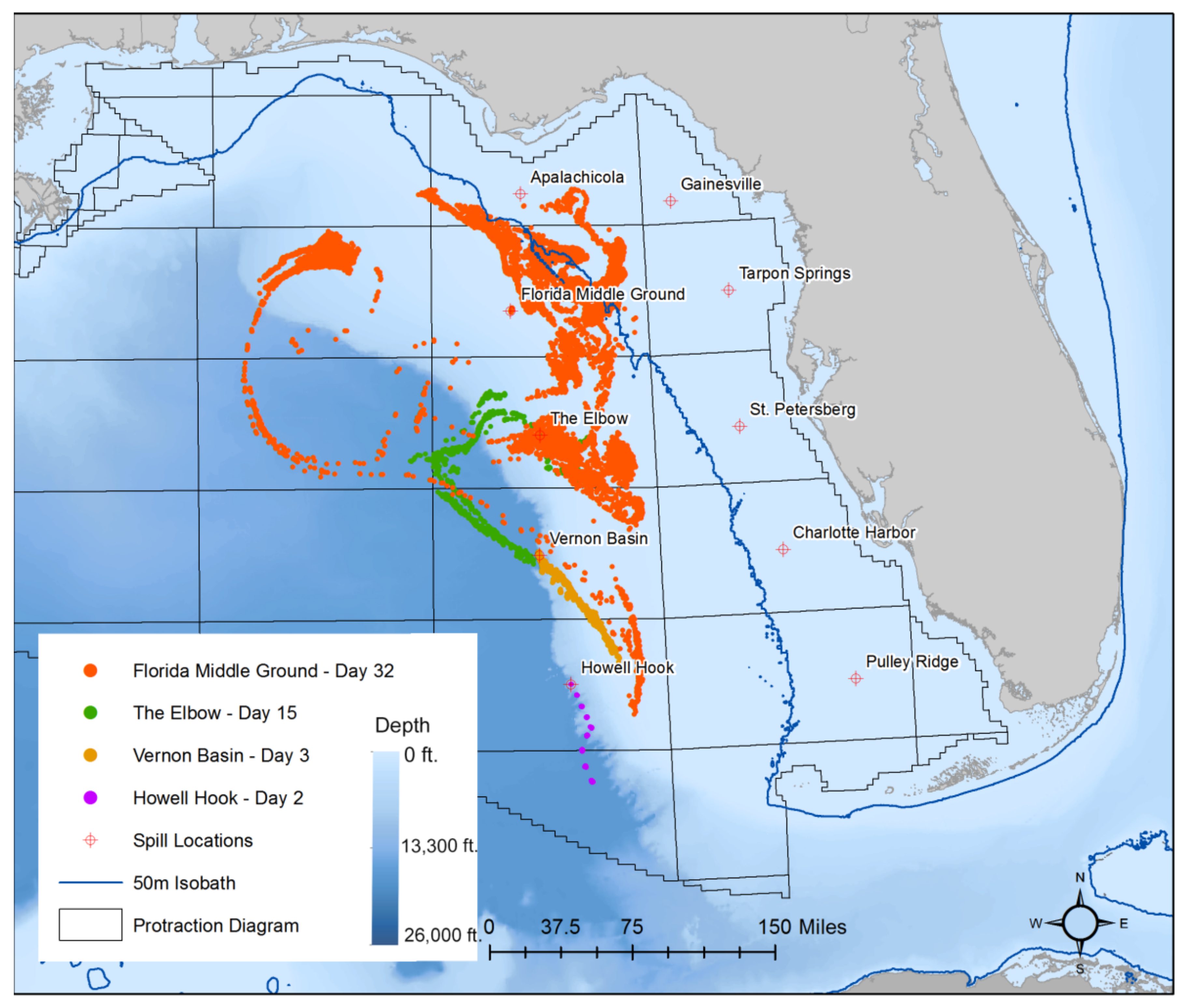
References
- Energy Information Administration (EIA). Energy Information Administration Gulf of Mexico Fact Sheet. Available online: https://www.eia.gov/special/gulf_of_mexico/ (accessed on 15 February 2018).
- Louisiana State University (LSU). Gulf Coast Energy Outlook. Available online: https://www.lsu.edu/ces/publications/2017/GCEO2017.pdf (accessed on 25 February 2018).
- Kazanis, E.; Maclay, D.; Shepard, N. Estimated Oil and Gas Reserves Gulf of Mexico OCS Region December 31, 2013; Bureau of Ocean Energy Management (BOEM) Report; BOEM: New Orleans, LA, USA, 2015. [Google Scholar]
- Sovacool, B.K. Solving the oil independence problem: Is it possible? Energy Policy 2007, 35, 5505–5514. [Google Scholar] [CrossRef]
- Peterson, C.H.; Rice, S.D.; Short, J.W.; Esler, D.; Bodkin, J.L.; Ballachey, B.E.; Irons, D.B. Long-term ecosystem response to the Exxon Valdez oil spill. Science 2003, 302, 2082–2086. [Google Scholar] [CrossRef] [PubMed]
- Silliman, B.R.; van de Koppel, J.; McCoy, M.W.; Diller, J.; Kasozi, G.N.; Earl, K.; Adams, P.N.; Zimmerman, A.R. Degradation and resilience in Louisiana salt marshes after the BP-Deepwater Horizon oil spill. Proc. Natl. Acad. Sci. USA 2012, 109, 11234–11239. [Google Scholar] [CrossRef] [PubMed]
- Graham, B.; Reilly, W.K.; Beinecke, F.; Boesch, D.F.; Garcia, T.D.; Murray, C.A.; Ulmer, F. Deep Water: The Gulf Oil Disaster and the Future of Offshore Drilling: Report to the President; National Commission on the BP Deepwater Horizon Oil Spill and Offshore Drilling; U.S. Government Publishing Office: Washington, DC, USA, 2011.
- Sumaila, U.R.; Cisneros-Montemayor, A.M.; Dyck, A.; Huang, L.; Cheung, W.; Jacquet, J.; Kleisner, K.; Lam, V.; McCrea-Strub, A.; Swartz, W.; et al. Impact of the Deepwater Horizon well blowout on the economics of US Gulf fisheries. Can. J. Fish. Aquat. Sci. 2012, 69, 499–510. [Google Scholar] [CrossRef]
- Smith, L.C.; Smith, M.; Ashcroft, P. Analysis of environmental and economic damages from British Petroleum’s Deepwater Horizon oil spill. Albany Law Rev. 2011, 74, 563–585. [Google Scholar] [CrossRef]
- Court, C.D.; Hodges, A.W.; Clouser, R.L.; Larkin, S.L. Economic impacts of cancelled recreational trips to Northwest Florida after the Deepwater Horizon oil spill. Reg. Sci. Policy Pract. 2017, 9, 143–164. [Google Scholar] [CrossRef]
- Mufson, S. Shell’s Brutus production platform spills oil into Gulf of Mexico. Washington Post, 13 May 2016. [Google Scholar]
- Grant, N. Gulf Coast Oil Spill May Be Largest Since 2010 BP Disaster. Bloomberg, 16 October 2017. [Google Scholar]
- DOI Secretary Zinke Announces Plan For Unleashing America’s Offshore Oil and Gas Potential. Available online: https://www.doi.gov/pressreleases/secretary-zinke-announces-plan-unleashing-americas-offshore-oil-and-gas-potential (accessed on 2 February 2018).
- Tabuchi, H. Trump Administration Drops Florida From Offshore Drilling Plan. New York Times, 9 January 2018. [Google Scholar]
- Sissine, F. Energy Independence and Security Act of 2007: A Summary of Major Provisions; Congressional Research Service (Library of Congress): Washington, DC, USA, 2007. [Google Scholar]
- Dixon, M.; Ritchie, B. GOP congressmen say Ryan to push permanent moratorium on eastern Gulf drilling. Politico, 8 January 2018. [Google Scholar]
- Nelson, J.R.; Grubesic, T.H. Oil spill modeling: Risk, spatial vulnerability, and impact assessment. Prog. Phys. Geogr. 2017, 42, 112–127. [Google Scholar] [CrossRef]
- Olita, A.; Cucco, A.; Simeone, S.; Ribotti, A.; Fazioli, L.; Sorgente, B.; Sorgente, R. Oil spill hazard and risk assessment for the shorelines of a Mediterranean coastal archipelago. Ocean Coast. Manag. 2012, 57, 44–52. [Google Scholar] [CrossRef]
- Madrid, J.A.J.; García-Ladona, E.; Blanco-Meruelo, B. Oil Spill Beaching Probability for the Mediterranean Sea; The Handbook of Environmental Chemistry: Berlin, Germany, 2016; pp. 1–20. [Google Scholar]
- Canu, D.M.; Solidoro, C.; Bandelj, V.; Quattrocchi, G.; Sorgente, R.; Olita, A.; Fazioli, L.; Cucco, A. Assessment of oil slick hazard and risk at vulnerable coastal sites. Mar. Pollut. Bull. 2015, 94, 84–95. [Google Scholar] [CrossRef] [PubMed]
- Castanedo, S.; Juanes, J.A.; Medina, R.; Puente, A.; Fernandez, F.; Olabarrieta, M.; Pombo, C. Oil spill vulnerability assessment integrating physical, biological and socio-economical aspects: Application to the Cantabrian coast (Bay of Biscay, Spain). J. Environ. Manag. 2009, 91, 149–159. [Google Scholar] [CrossRef] [PubMed]
- Lan, D.; Liang, B.; Bao, C.; Ma, M.; Xu, Y.; Yu, C. Marine oil spill risk mapping for accidental pollution and its application in a coastal city. Mar. Pollut. Bull. 2015, 96, 220–225. [Google Scholar] [CrossRef] [PubMed]
- Lee, M.; Jung, J.-Y. Pollution risk assessment of oil spill accidents in Garorim Bay of Korea. Mar. Pollut. Bull. 2015, 100, 297–303. [Google Scholar] [CrossRef] [PubMed]
- Nelson, J.; Grubesic, T.; Sim, L.; Rose, K.; Graham, J. Approach for assessing coastal vulnerability to oil spills for prevention and readiness using GIS and the Blowout and Spill Occurrence Model. Ocean Coast. Manag. 2015, 112, 1–11. [Google Scholar] [CrossRef]
- French McCay, D.; Rowe, J.J.; Whittier, N.; Sankaranarayanan, S.; Schmidt Etkin, D. Estimation of potential impacts and natural resource damages of oil. J. Hazard. Mater. 2004, 107, 11–25. [Google Scholar] [CrossRef] [PubMed]
- Cama, T. Zinke Talks with More Governors about Offshore Drilling Plan; The Hill: Washington, DC, USA, 2018; Available online: http://thehill.com/policy/energy-environment/368813-zinke-talks-with-more-governors-about-offshore-drilling-plan (accessed on 5 February 2018).
- Klein, Y.L.; Osleeb, J.P.; Viola, M.R. Tourism-generated earnings in the coastal zone: A regional analysis. J. Coast. Res. 2004, 20, 1080–1088. [Google Scholar] [CrossRef]
- FLGov Governor Scott Applauds Florida’s Tourism Marketing. Available online: https://www.flgov.com/governor-scott-applauds-floridas-tourism-marketing-2/ (accessed on 25 February 2018).
- Pforr, C. Crisis management in tourism: A review of the emergent literature. In Crisis Management in the Tourism Industry: Beating the Odds; Pforr, C., Hosie, P., Eds.; Ashgate: Burlington, NJ, USA, 2009; pp. 37–52. [Google Scholar]
- Ritchie, B.W. Chaos, crises and disasters: A strategic approach to crisis management in the tourism industry. Tour. Manag. 2004, 25, 669–683. [Google Scholar] [CrossRef]
- Boufadel, M.C.; Abdollahi-Nasab, A.; Geng, X.; Galt, J.; Torlapati, J. Simulation of the landfall of the deepwater horizon oil on the shorelines of the Gulf of Mexico. Environ. Sci. Technol. 2014, 48, 9496–9505. [Google Scholar] [CrossRef] [PubMed]
- Camilli, R.; Reddy, C.M.; Yoerger, D.R.; Van Mooy, B.A.S.; Jakuba, M.V.; Kinsey, J.C.; McIntyre, C.P.; Sylva, S.P.; Maloney, J.V. Tracking hydrocarbon plume transport and biodegradation at Deepwater Horizon. Science 2010, 330, 201–204. [Google Scholar] [CrossRef] [PubMed]
- Passow, U.; Ziervogel, K.; Asper, V.; Diercks, A. Marine snow formation in the aftermath of the Deepwater Horizon oil spill in the Gulf of Mexico. Environ. Res. Lett. 2012, 7, 35301. [Google Scholar] [CrossRef]
- Montagna, P.A.; Baguley, J.G.; Cooksey, C.; Hartwell, I.; Hyde, L.J.; Hyland, J.L.; Kalke, R.D.; Kracker, L.M.; Reuscher, M.; Rhodes, A.C.E. Deep-sea benthic footprint of the Deepwater Horizon blowout. PLoS ONE 2013, 8, e70540. [Google Scholar] [CrossRef] [PubMed] [Green Version]
- Felder, D.L.; Thoma, B.P.; Schmidt, W.E.; Sauvage, T.; Self-Krayesky, S.L.; Chistoserdov, A.; Bracken-Grissom, H.D.; Fredericq, S. Seaweeds and decapod crustaceans on Gulf deep banks after the Macondo Oil Spill. Bioscience 2014, 64, 808–819. [Google Scholar] [CrossRef]
- Fisher, C.R.; Demopoulos, A.W.J.; Cordes, E.E.; Baums, I.B.; White, H.K.; Bourque, J.R. Coral communities as indicators of ecosystem-level impacts of the Deepwater Horizon spill. Bioscience 2014, 64, 796–807. [Google Scholar] [CrossRef]
- Etnoyer, P.J.; Wickes, L.N.; Silva, M.; Dubick, J.D.; Balthis, L.; Salgado, E.; MacDonald, I.R. Decline in condition of gorgonian octocorals on mesophotic reefs in the northern Gulf of Mexico: Before and after the Deepwater Horizon oil spill. Coral Reefs 2016, 35, 77–90. [Google Scholar] [CrossRef]
- Dubansky, B.; Whitehead, A.; Miller, J.T.; Rice, C.D.; Galvez, F. Multitissue molecular, genomic, and developmental effects of the Deepwater Horizon oil spill on resident Gulf killifish (Fundulus grandis). Environ. Sci. Technol. 2013, 47, 5074–5082. [Google Scholar] [CrossRef] [PubMed]
- Tran, T.; Yazdanparast, A.; Suess, E.A. Effect of oil spill on birds: A graphical assay of the deepwater horizon oil spill’s impact on birds. Comput. Stat. 2014, 29, 133–140. [Google Scholar] [CrossRef]
- Haney, J.C.; Geiger, H.J.; Short, J.W. Bird mortality from the Deepwater Horizon oil spill. II. Carcass sampling and exposure probability in the coastal Gulf of Mexico. Mar. Ecol. Prog. Ser. 2014, 513, 239–252. [Google Scholar] [CrossRef]
- Antonio, F.J.; Mendes, R.S.; Thomaz, S.M. Identifying and modeling patterns of tetrapod vertebrate mortality rates in the Gulf of Mexico oil spill. Aquat. Toxicol. 2011, 105, 177–179. [Google Scholar] [CrossRef] [PubMed]
- Schwacke, L.H.; Smith, C.R.; Townsend, F.I.; Wells, R.S.; Hart, L.B.; Balmer, B.C.; Collier, T.K.; De Guise, S.; Fry, M.M.; Guillette, L.J., Jr. Health of common bottlenose dolphins (Tursiops truncatus) in Barataria Bay, Louisiana, following the Deepwater Horizon oil spill. Environ. Sci. Technol. 2013, 48, 93–103. [Google Scholar] [CrossRef] [PubMed]
- Carmichael, R.H.; Graham, W.M.; Aven, A.; Worthy, G.; Howden, S. Were multiple stressors a “perfect storm”for northern Gulf of Mexico bottlenose dolphins (Tursiops truncatus) in 2011? PLoS ONE 2012, 7, e41155. [Google Scholar] [CrossRef] [PubMed]
- McCrea-Strub, A.; Kleisner, K.; Sumaila, U.R.; Swartz, W.; Watson, R.; Zeller, D.; Pauly, D. Potential Impact of the Deepwater Horizon Oil Spill on Commercial Fisheries in the Gulf of Mexico. Fisheries 2011, 36, 332–336. [Google Scholar] [CrossRef]
- Bishop, R.C.; Boyle, K.J.; Carson, R.T.; Chapman, D.; Hanemann, W.M.; Kanninen, B.; Kopp, R.J.; Krosnick, J.A.; List, J.; Meade, N.; et al. Putting a value on injuries to natural assets: The BP oil spill. Science 2017, 356, 253–254. [Google Scholar] [CrossRef] [PubMed]
- Duran, R.; Beron-Vera, F.J.; Olascoaga, M.J. Extracting quasi-steady Lagrangian transport patterns from the ocean circulation: An application to the Gulf of Mexico. Sci. Rep. 2018, 8. [Google Scholar] [CrossRef] [PubMed]
- Wang, S.D.; Shen, Y.M.; Zheng, Y.H. Two-dimensional numerical simulation for transport and fate of oil spills in seas. Ocean Eng. 2005, 32, 1556–1571. [Google Scholar] [CrossRef]
- White, H.K.; Hsing, P.-Y.; Cho, W.; Shank, T.M.; Cordes, E.E.; Quattrini, A.M.; Nelson, R.K.; Camilli, R.; Demopoulos, A.W.J.; German, C.R. Impact of the Deepwater Horizon oil spill on a deep-water coral community in the Gulf of Mexico. Proc. Natl. Acad. Sci. USA 2012, 109, 20303–20308. [Google Scholar] [CrossRef] [PubMed]
- Grubesic, T.H.; Wei, R.; Nelson, J. Optimizing oil spill cleanup efforts: A tactical approach and evaluation framework. Mar. Pollut. Bull. 2017, 125, 318–329. [Google Scholar] [CrossRef] [PubMed]
- Jensen, J.R.; Ramsey, E.W., III; Holmes, J.M.; Michel, J.E.; Savitsky, B.; Davis, B.A. Environmental sensitivity index (ESI) mapping for oil spills using remote sensing and geographic information system technology. Int. J. Geogr. Inf. Syst. 1990, 4, 181–201. [Google Scholar] [CrossRef]
- Romero, A.F.; Abessa, D.M.S.; Fontes, R.F.C.; Silva, G.H. Integrated assessment for establishing an oil environmental vulnerability map: Case study for the Santos Basin region, Brazil. Mar. Pollut. Bull. 2013, 74, 156–164. [Google Scholar] [CrossRef] [PubMed]
- Carmona, A.S.L.; Gherardi, D.F.M.; Tessler, M.G.; Carmonaf, S.L. Environment Sensitivity Mapping and Vulnerability Modeling for Oil Spill Response along the São Paulo State Coastline. J. Coast. Res. 2006, 1455–1458. [Google Scholar]
- Fattal, P.; Maanan, M.; Tillier, I.; Rollo, N.; Robin, M.; Pottier, P. Coastal Vulnerability to Oil Spill Pollution: The Case of Noirmoutier Island (France). J. Coast. Res. 2010, 879–887. [Google Scholar] [CrossRef]
- Boer, S.; Azevedo, A.; Vaz, L.; Costa, R.; Fortunato, A.B.; Oliveira, A.; Tomás, L.M.; Dias, J.M.; Rodrigues, M. Development of an oil spill hazard scenarios database for risk assessment. J. Coast. Res. 2014, 70, 539–544. [Google Scholar] [CrossRef]
- Guillen, G.; Rainey, G.; Morin, M. A simple rapid approach using coupled multivariate statistical methods, GIS and trajectory models to delineate areas of common oil spill risk. J. Mar. Syst. 2004, 45, 221–235. [Google Scholar] [CrossRef]
- Fernández-Macho, J. Risk assessment for marine spills along European coastlines. Mar. Pollut. Bull. 2016, 113, 200–210. [Google Scholar] [CrossRef] [PubMed]
- Azevedo, A.; Fortunato, A.B.; Epifânio, B.; den Boer, S.; Oliveira, E.R.; Alves, F.L.; de Jesus, G.; Gomes, J.L.; Oliveira, A. An oil risk management system based on high-resolution hazard and vulnerability calculations. Ocean Coast. Manag. 2017, 136, 1–18. [Google Scholar] [CrossRef]
- BOEM Offshore Statistics by Water Depth. Available online: https://www.data.boem.gov/Leasing/OffshoreStatsbyWD/Default.aspx (accessed on 5 December 2017).
- BOEM Official Protraction Diagrams (OPDs) and Leasing Maps (LMs) & Supplemental Official OCS Block Diagrams (SOBDs). Available online: https://www.boem.gov/Official-Protraction-Diagrams/ (accessed on 2 December 2017).
- Sturges, W.; Leben, R. Frequency of ring separations from the Loop Current in the Gulf of Mexico: A revised estimate. J. Phys. Oceanogr. 2000, 30, 1814–1819. [Google Scholar] [CrossRef]
- Socolofsky, S.A.; Adams, E.E.; Boufadel, M.C.; Aman, Z.M.; Johansen, Ø.; Konkel, W.J.; Lindo, D.; Madsen, M.N.; North, E.W.; Paris, C.B. Intercomparison of oil spill prediction models for accidental blowout scenarios with and without subsea chemical dispersant injection. Mar. Pollut. Bull. 2015, 96, 110–126. [Google Scholar] [CrossRef] [PubMed]
- Sim, L.; Graham, J.; Rose, K.; Duran, R.; Nelson, J.; Umhoefer, J.; Vielma, J. Developing a Comprehensive Deepwater Blowout and Spill Model; 2015 NETLTRS-9-2015; EPAct Technical Report Series; U.S. Department of Energy; National Energy Technology Laboratory: Albany, OR, USA, 2015; p. 44.
- NOAA Naval Oceanographic Office Regional Navy Coastal Ocean Model (NCOM). Available online: https://www.ncdc.noaa.gov/data-access/model-data/model-datasets/navoceano-ncom-reg (accessed on 2 January 2018).
- Network Common Data Form (NetCDF). NetCDF: Introduction and Overview. Available online: http://www.unidata.ucar.edu/software/netcdf/docs/index.html (accessed on 20 December 2017).
- Lehr, W.J.; Cekirge, H.M.; Fraga, R.J.; Belen, M.S. Empirical studies of the spreading of oil spills. Oil Petrochem. Pollut. 1984, 2, 7–11. [Google Scholar] [CrossRef]
- Rasmussen, D. Oil spill modeling—A tool for cleanup operations. In International Oil Spill Conference; American Petroleum Institute: Washing, DC, USA, 1985; Volume 1985, pp. 243–249. [Google Scholar]
- Mackay, D. Calculation of the evaporation rate of volatile liquids. In Proceedings of the National Conference on Control of Hazardous Material Spills, Louisville, KY, USA, 13–15 May 1980. [Google Scholar]
- Tkalin, A.V. Evaporation of petroleum hydrocarbons from films on a smooth sea surface. Oceanol. Acad. Sci. USSR 1986, 26, 473–474. [Google Scholar]
- Kankara, R.S.; Arockiaraj, S.; Prabhu, K. Environmental sensitivity mapping and risk assessment for oil spill along the Chennai Coast in India. Mar. Pollut. Bull. 2016, 106, 95–103. [Google Scholar] [CrossRef] [PubMed]
- Banerjee, T.; Gollub, J.O. The Public View of the Coast: Toward Aesthetic Indicators for Coastal Planning and Management. In Behavioral Basis of Design; Suedfeld, P., Russell, J.A., Eds.; ERDA Inc. and Russell Dowden, Hutchinson and Ross Inc.: Stroudsburg, PA, USA, 1976; pp. 115–122. [Google Scholar]
- Brody, S.D.; Grover, H.; Bernhardt, S.; Tang, Z.; Whitaker, B.; Spence, C. Identifying potential conflict associated with oil and gas exploration in Texas state coastal waters: A multicriteria spatial analysis. Environ. Manag. 2006, 38, 597–617. [Google Scholar] [CrossRef] [PubMed]
- Costanza, R.; d’Arge, R.; De Groot, R.; Farber, S.; Grasso, M.; Hannon, B.; Limburg, K.; Naeem, S.; O’neill, R.V.; Paruelo, J. The value of the world’s ecosystem services and natural capital. Nature 1997, 387, 253–260. [Google Scholar] [CrossRef]
| 1 | We readily acknowledge that spill locations and their local environmental conditions are important factors to consider, but these details will be explored in future research efforts. |
| 2 | Although this modifier improves comparability between scenarios, it also unintentionally obfuscates the overall impacts of oil in coastal locations. Any amount of oil that comes into contact with the shoreline is a problem. |
| 3 | It is likely that the spills would be much larger if the simulated scenarios were not restricted to the boundary of the current files used for analysis. |
| 4 | Again, data restrictions and project scope limit our ability to gain a comprehensive picture of what that means in terms of final impacts. |
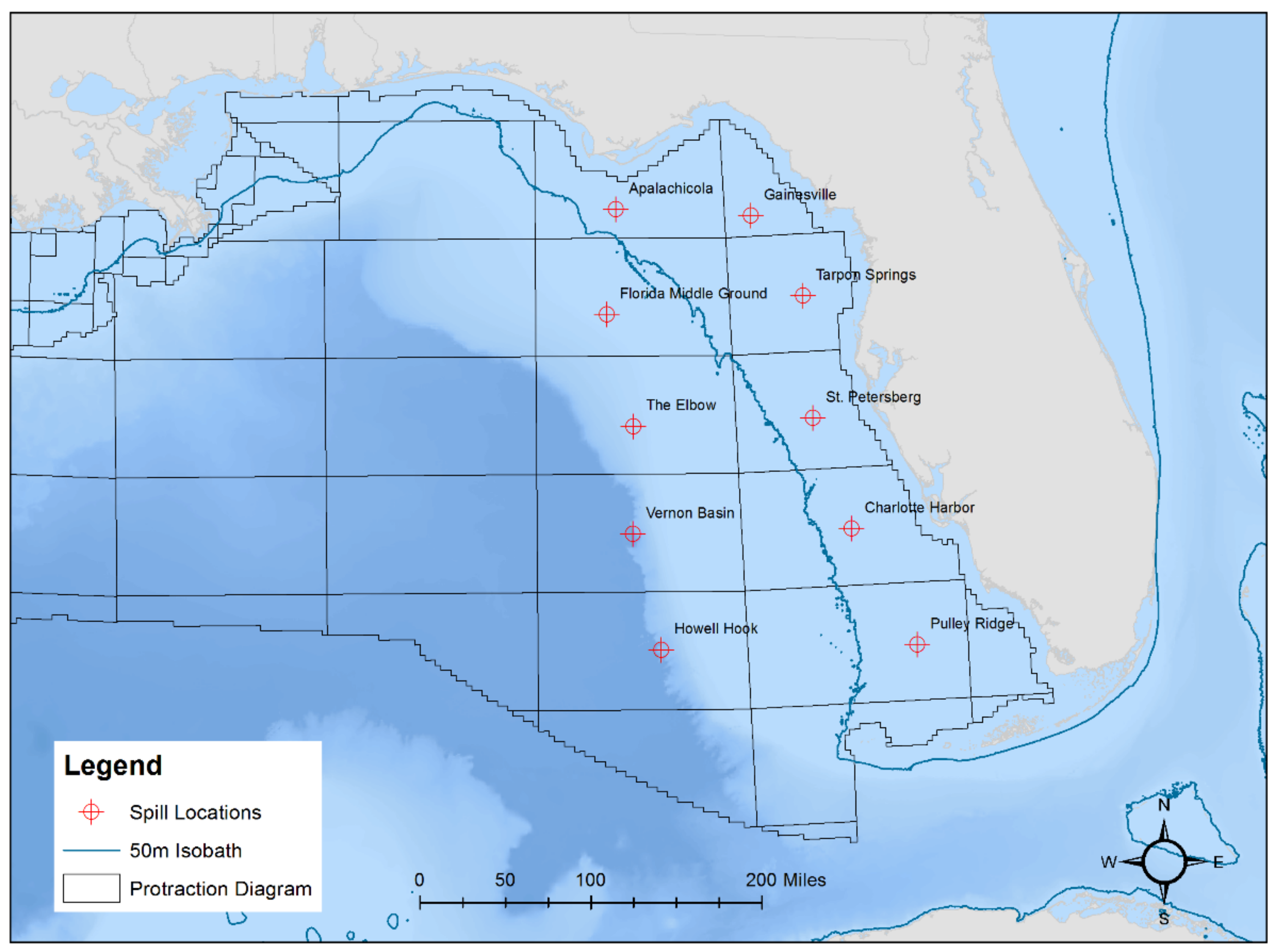

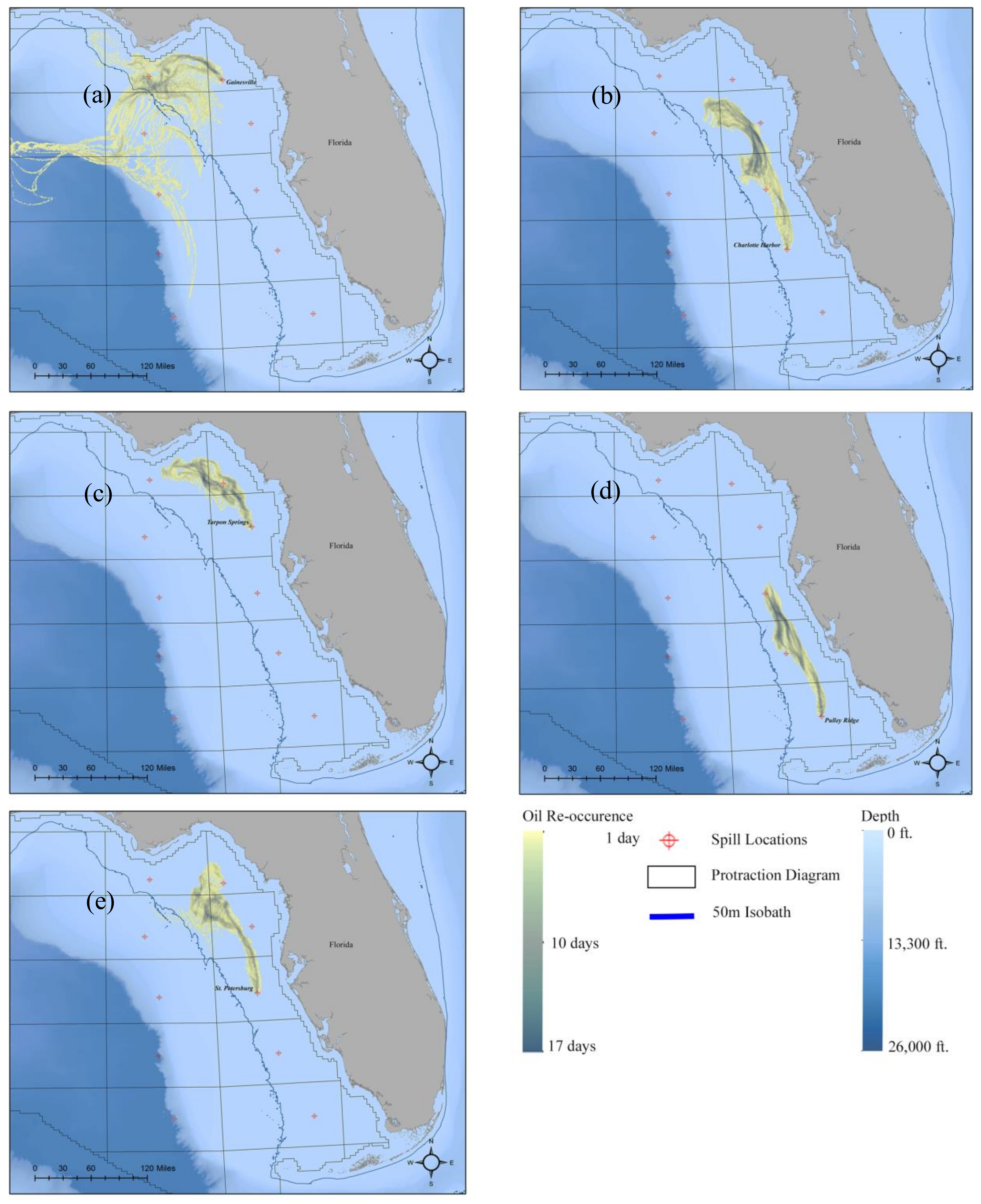
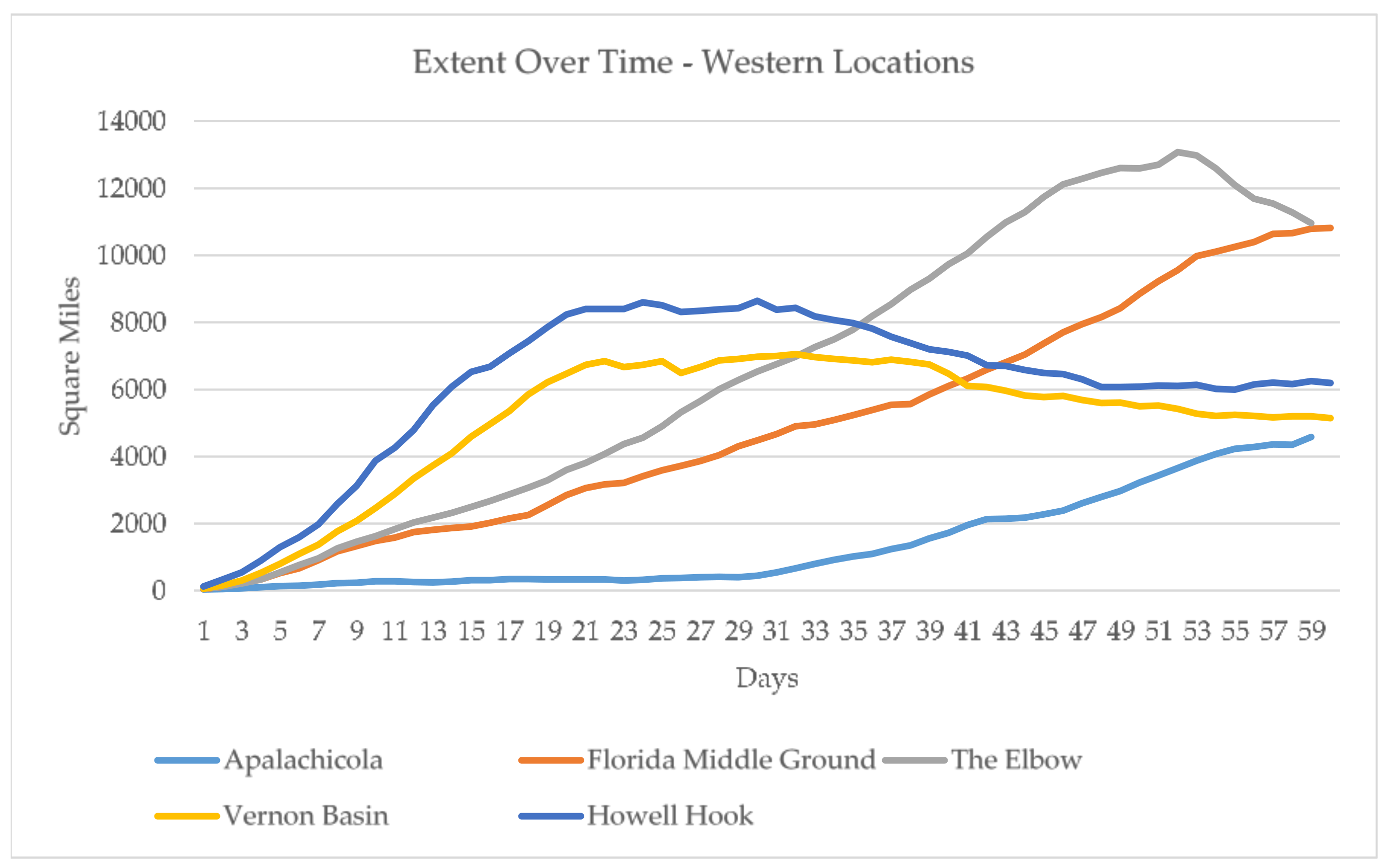
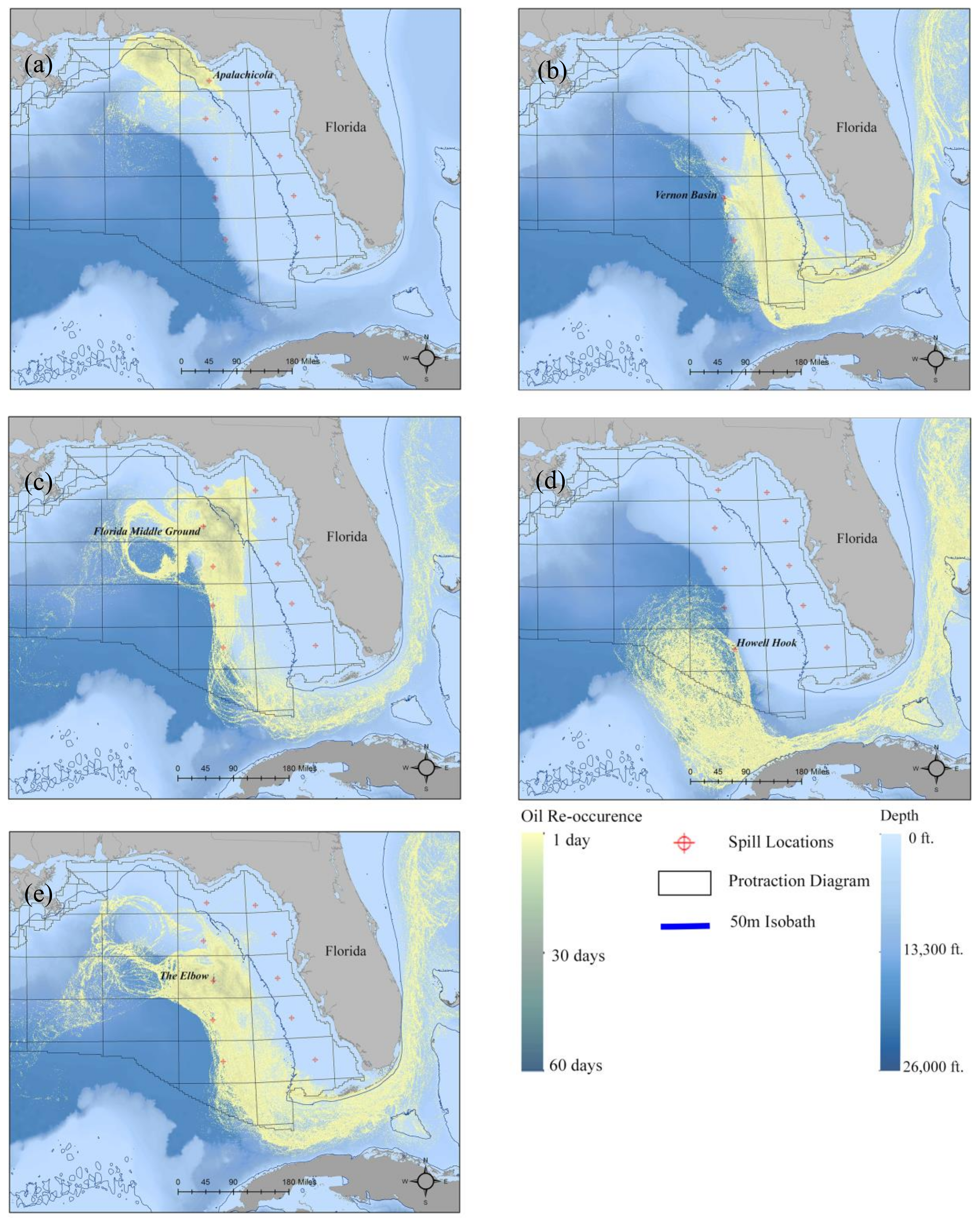

| Spill Scenario | Latitude | Longitude | Depth (m) | June Average Current Velocity (North, m/s) | July Average Current Velocity (North, m/s) | June Average Current Velocity (East, m/s) | July Average Current Velocity (East, m/s) |
|---|---|---|---|---|---|---|---|
| Eastern Locations | |||||||
| Gainesville | 29.12 N | −83.79 W | 62.33 | 0.037 | −0.013 | −0.021 | 0.02 |
| Tarpon Springs | 28.43 N | −83.32 W | 62.43 | 0.049 | −0.001 | −0.015 | −0.0009 |
| St. Petersburg | 27.39 N | −83.26 W | 111.54 | 0.092 | −0.001 | −0.03 | 0.001 |
| Charlotte Harbor | 26.44 N | −82.93 W | 121.39 | 0.088 | 0.008 | −0.017 | −0.007 |
| Pulley Ridge | 25.43 N | −82.36 W | 91.86 | 0.047 | 0.011 | −0.017 | −0.016 |
| Western Locations | |||||||
| Apalachicola | 29.21 N | −85.10 W | 104.98 | 0.033 | −0.024 | −0.05 | 0.059 |
| Florida Middle Ground | 28.32 N | −85.2 W | 600.39 | 0.015 | −0.004 | −0.014 | −0.002 |
| The Elbow | 27.36 N | −84.97 W | 1417.32 | −0.049 | −0.058 | 0.049 | 0.113 |
| Vernon Basin | 26.45 N | −85.00 W | 10833.33 | 0.039 | −0.186 | −0.062 | 0.1 |
| Howell Hook | 25.46 N | −84.76 W | 5754.59 | −0.22 | −0.764 | 0.494 | 0.208 |
| Spill Scenario | Total Coastal Oil (Gallons) | Total Coastal Assets Impacted | Total Oil in Open Water Remaining (Gallons) | Total Open Water Assets Impacted |
|---|---|---|---|---|
| Eastern Scenarios | ||||
| Gainesville | 0 | 0 | 90,932.89 | 23,307 |
| Tarpon Springs | 0 | 0 | 84,304.82 | 11,277 |
| St. Petersburg | 0 | 0 | 88,429.15 | 12,407 |
| Charlotte Harbor | 0 | 0 | 87,356.18 | 14,687 |
| Pulley Ridge | 0 | 0 | 84,439.23 | 9056 |
| Western Scenarios | ||||
| Vernon Basin | 7243 | 1752 | 23,073.15 | 49,498 |
| Howell Hook | 10,953.14 | 0 | 26,873.38 | 12,517 |
| Florida Middle Ground | 252.31 | 307 | 78,702.33 | 51,676 |
| Apalachicola | 190.92 | 142 | 85,861.80 | 32,123 |
| The Elbow | 5234.70 | 1878 | 51,711.00 | 67,948 |
| Spill Scenario | Total Open Water Impact | Scaled Open Water Impact | Total Coastal Impact | Coastal Impact Scaled | Remaining Water Column Oil Impact | Overall Impact |
|---|---|---|---|---|---|---|
| Eastern Locations | ||||||
| Gainesville | 680.72 | 8.05 | 0 | 0 | 5.00 | 13.05 |
| Tarpon Springs | 807.56 | 9.47 | 0 | 0 | 4.61 | 14.08 |
| St. Petersburg | 855.4 | 10.00 | 0 | 0 | 4.85 | 14.85 |
| Charlotte Harbor | 767.27 | 9.02 | 0 | 0 | 4.79 | 13.81 |
| Pulley Ridge | 704.98 | 8.33 | 0 | 0 | 4.62 | 12.94 |
| Western Locations | ||||||
| Vernon Basin | 164.63 | 2.31 | 143.51 | 10.00 | 1.00 | 13.31 |
| Howell Hook | 47.159 | 1.00 | 0 | 1.00 | 1.22 | 3.22 |
| Florida Middle Ground | 398.012 | 4.91 | 0.15 | 1.01 | 4.28 | 10.20 |
| Apalachicola | 737.57 | 8.69 | 2.23 | 1.14 | 4.70 | 14.53 |
| The Elbow | 303.36 | 3.85 | 92.63 | 6.81 | 2.69 | 13.35 |
© 2018 by the authors. Licensee MDPI, Basel, Switzerland. This article is an open access article distributed under the terms and conditions of the Creative Commons Attribution (CC BY) license (http://creativecommons.org/licenses/by/4.0/).
Share and Cite
Nelson, J.R.; Grubesic, T.H. The Implications of Oil Exploration off the Gulf Coast of Florida. J. Mar. Sci. Eng. 2018, 6, 30. https://doi.org/10.3390/jmse6020030
Nelson JR, Grubesic TH. The Implications of Oil Exploration off the Gulf Coast of Florida. Journal of Marine Science and Engineering. 2018; 6(2):30. https://doi.org/10.3390/jmse6020030
Chicago/Turabian StyleNelson, Jake R., and Tony H. Grubesic. 2018. "The Implications of Oil Exploration off the Gulf Coast of Florida" Journal of Marine Science and Engineering 6, no. 2: 30. https://doi.org/10.3390/jmse6020030





